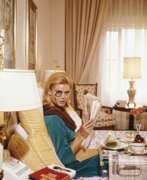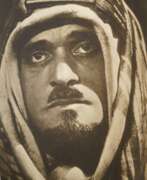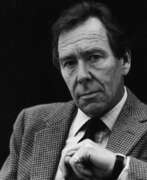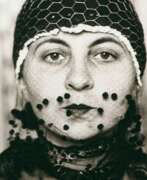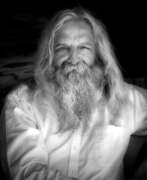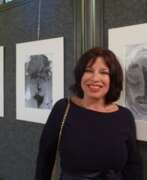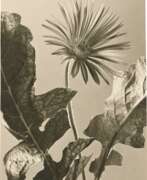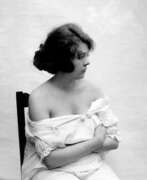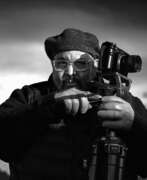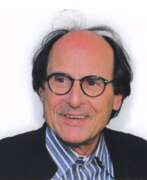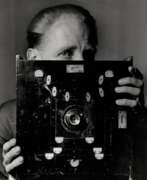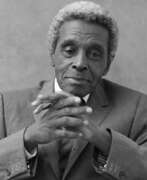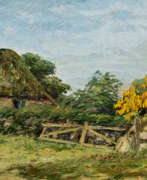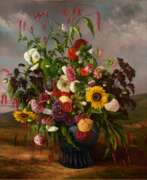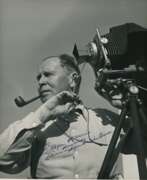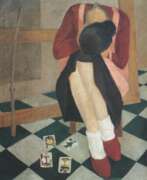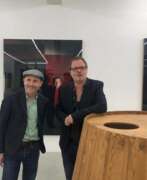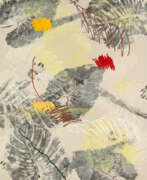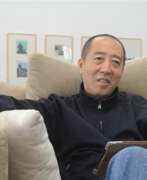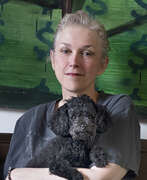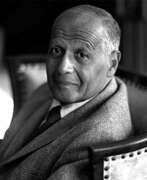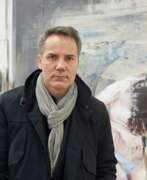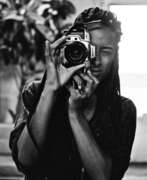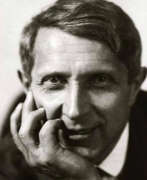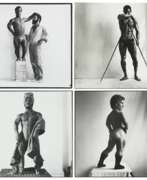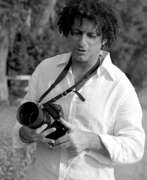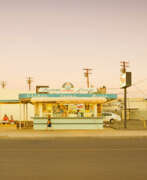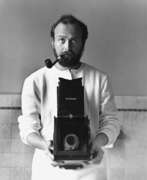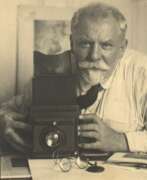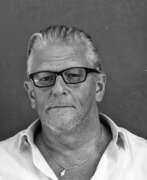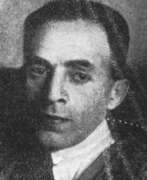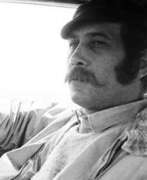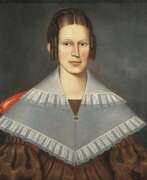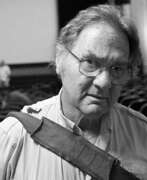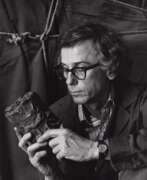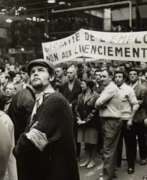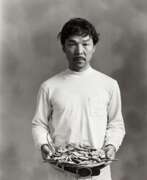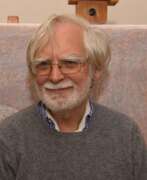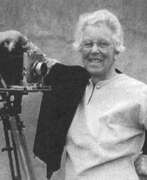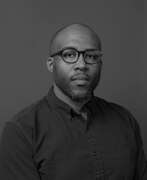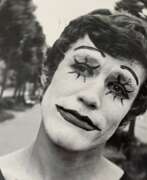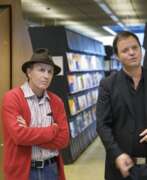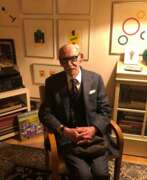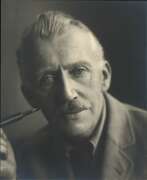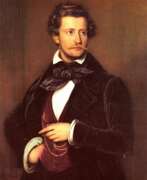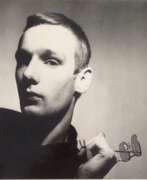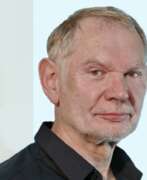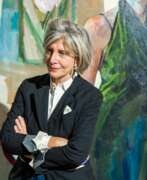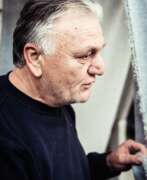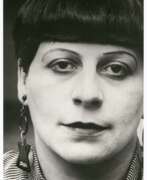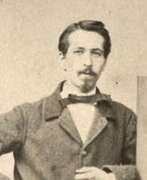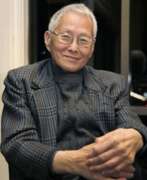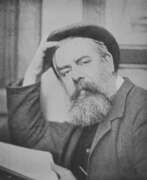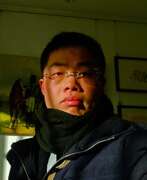Photographers Portrait


Herbert Ritts Jr. was an American fashion photographer and director known for his photographs of celebrities, models, and other cultural figures throughout the 1980s and 1990s. His work concentrated on black and white photography and portraits, often in the style of classical Greek sculpture, which emphasized the human shape.
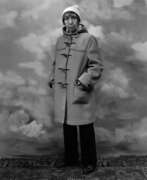

Berenice Alice Abbott was an American photographer best known for her portraits of between-the-wars 20th century cultural figures, New York City photographs of architecture and urban design of the 1930s, and science interpretation in the 1940s to 1960s.
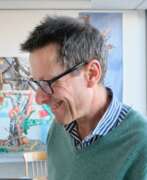

Urs Aeschbach is a Swiss media artist working in various techniques. Nature is always a pictorial theme in Urs Aeschbach's paintings. Her main characters are mushrooms, woody plants, animals, jellyfish, as well as dogs and horses. The artist's paintings are inspired by photographs and illustrations. In addition to paintings, Eschbach creates art and construction projects, video works, as well as constructions and installations.
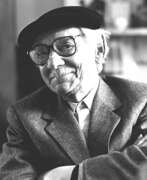

Manuel Álvarez Bravo was an Mexican visionary photographer whose work vividly illustrates the cultural heritage of Latin America. His unique perspective on life and superb photographic skills have inspired generations of photographers around the world.
Alvarez Bravo was known for his experiments with light and shadows, composition and form. His surreal photographs were often full of mystery and enigma, while also reflecting the difficulties and contradictions of Mexican society in the first half of the 20th century.
Alvarez Bravo's work marvellously combined aesthetic beauty with profound social context. His work is not only inspiring in its beauty but also a reminder of the importance of preserving peoples' cultural heritage and history.
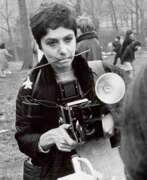

Diane Arbus was an American photographer. Arbus's imagery helped to normalize marginalized groups and highlight the importance of proper representation of all people. She photographed a wide range of subjects including strippers, carnival performers, nudists, people with dwarfism, children, mothers, couples, elderly people, and middle-class families.


Ellen Auerbach, born Ellen Rosenberg, is an American photographer of German-Jewish descent and a master of avant-garde photography.
Ellen studied at the Baden State School of Art and continued her studies at the Academy of Fine Arts in Stuttgart before meeting photographer Greta Stern (1904-1999) in Berlin. Together they opened Ringl+pit, a photography and design studio specializing in advertising, fashion and portrait photography. The photographer is most remembered for her groundbreaking work at this particular studio. Ellen, who also experimented with film, made two short black-and-white films.
In 1933, Ellen emigrated to Palestine and opened a children's portrait studio there. A few years later she moved with her husband Walter Auerbach to the United States, where she worked in a private art collection, taught photography, made films and photographs to study children's behavior, and worked as an educational therapist.
The Ringl+pit works and photographic oeuvre of Ellen Auerbach and Greta Stern were rediscovered in the 1980s, and a series of solo and group exhibitions in the United States and Germany followed.
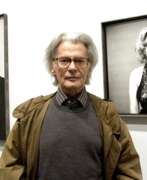

Richard Avedon was an American photographer and artist known for his iconic portraits and fashion photography.
Avedon began his career as a photographer in the late 1940s, working as a freelance photographer for magazines such as Harper's Bazaar and Vogue. He soon became known for his distinctive style, which was characterized by his use of simple, uncluttered backgrounds and his ability to capture the essence of his subjects.
Throughout his career, Avedon photographed some of the most famous people of his time, including Marilyn Monroe, Andy Warhol, and The Beatles. He was also known for his fashion photography, and his work appeared in many fashion magazines, including Harper's Bazaar and Vogue.
Avedon's work was often controversial, as he challenged traditional notions of beauty and fashion. He was known for his willingness to push boundaries, and his work was often seen as a reflection of the social and political issues of his time.
Today, Avedon is regarded as one of the most important photographers of the 20th century, and his work continues to inspire artists and photographers around the world.
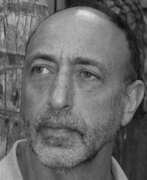

Roger Ballen is an American and South African photographer who lives and works in Johannesburg.
Roger Ballen studied psychology at the University of California, Berkeley, and this specialty helps him to better comprehend and study the world around him. Travels around the world brought him to South Africa, which has become his new home.
Ballen is one of the latest photographers to shoot exclusively in black and white, approaching forms of minimalism.
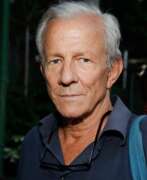

Peter Hill Beard was an American artist, photographer, diarist, and writer who lived and worked in New York City, Montauk and Kenya. His photographs of Africa, African animals and the journals that often integrated his photographs, have been widely shown and published since the 1960s.
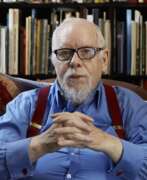

Peter Thomas Blake is an English pop artist. He co-created the sleeve design for the Beatles' album Sgt. Pepper's Lonely Hearts Club Band. His other works include the covers for two of The Who's albums, the cover of the Band Aid single "Do They Know It's Christmas?", and the Live Aid concert poster. Blake also designed the 2012 Brit Award statuette.
Blake is a prominent figure in the pop art movement. Central to his paintings are his interest in images from popular culture which have infused his collages. In 2002 he was knighted at Buckingham Palace for his services to art.
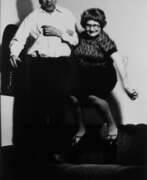

Bernhard Johannes Blume is a German art photographer.
Bernhard Blume and his wife Anna Blume created many staged black and white photographs in which they themselves took part. They are considered among the pioneers of staged photography.
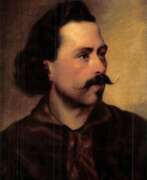

Jósef Borsos is a Hungarian portrait painter and photographer.
Borsos studied art at the Academy of Fine Arts in Vienna. He painted portraits of historical figures, but became best known for his genre paintings in the Biedermeier style.
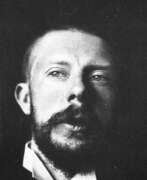

George Hendrik Breitner was a Dutch painter and photographer. An important figure in Amsterdam Impressionism, he is noted especially for his paintings of street scenes and harbours in a realistic style. He painted en plein air, and became interested in photography as a means of documenting street life and atmospheric effects — rainy weather in particular — as reference materials for his paintings.
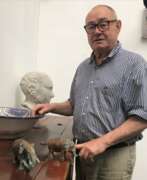

Johannes Brus is a German artist. He lives in Essen.
Brus works mainly as a sculptor and as a photographer. He experiments with different techniques with which he breaks the conventions of the respective genre. Many of his works are characterised by an idiosyncratic humour. Brus addresses aspects of cultural memory and the functions of images.


Harry Callahan was an American photographer and artist who is best known for his innovative and experimental work in the mid-20th century. He was began his artistic career as a painter before turning to photography.
Callahan's photographic work was characterized by his interest in abstraction, pattern, and form. He often photographed everyday objects and scenes, such as street signs, buildings, and landscapes, and used his camera to explore the beauty and complexity of the world around him.
Callahan was also known for his work as a teacher, and he taught photography at the Rhode Island School of Design for many years. His students included notable photographers such as Aaron Siskind and Ray K. Metzker, and he was known for his rigorous and challenging approach to teaching.
Callahan's legacy as an artist and photographer continues to influence contemporary photography and art. His innovative techniques and distinctive style continue to inspire new generations of artists, and his work is recognized as a significant contribution to the history of photography.
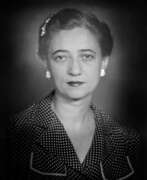

Ghitta Carell was the professional name of Ghitta Klein, a naturalized Italian photographer, born in Hungary, who came to prominence between 1930 and 1950. Noted for her portraiture, she was a favored photographer among the aristocracy and despite her Jewish heritage she helped build the imagery used in Fascist propaganda. After the fall of Mussolini, she remained in Italy, though her field of influence was greatly diminished. At the end of the 1960s, she immigrated to Israel, where she died in obscurity. Her archives, preserved by the 3M Foundation, have widely toured throughout Europe and a revival of interest in evaluating her skill as a technician has developed in the 21st century.


Pegg Clarke was an Australian professional fashion, portrait, architectural and society photographer whose work, published frequently in magazines, was referred to by historian Jack Cato as being of "the highest standard." Her work featured in prominent early 20th century Australian magazines. By the end of World War I Clarke was considered one of the leading photographers in Melbourne. She was respected for her fashion photography, ger high society portraits, especially of debutantes and brides and their portraits of visiting celebrities. Clarke was not trained at the National Gallery School, though she drew as well as photographed, but was involved with the Melbourne Society of Women Painters and Sculptors. In her personal work, mostly of landscape, Pegg was a Pictorialist.


Lucien Clergue is a French photographer of black and white photography, the first photographer elected a member of the French Academy of Fine Arts.
Lucien Clergue is one of the most famous photographers in France and founder of the annual Arles Festival, which has become the main event in the world of artistic photography, attended by up to 100,000 people. His famous photographic works - modernist black and white studies of female nudes, harlequins, dead animals, gypsies and bullfighting - are considered exemplary of the photographer-artist. Clergue is also known for his friendship with Pablo Picasso, which lasted some 30 years, until the artist's death.
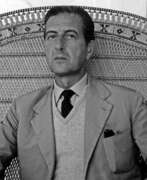

Fabrizio Clerici was an Italian painter, draftsman, illustrator, scenographer and architect.
Clerici earned a degree in architecture and was greatly influenced by antiquities, Renaissance and Baroque painting and architecture. In 1943, Clerici held his first solo exhibition at the Galleria dell'Arte Cairola in Milan, featuring drawings, watercolors, lithographs and etchings. His first book illustrations belong to the same period.
In 1947, Clerici began a prolific career in theater, ballet and opera with his debut as a stage designer in a production of George Bernard Shaw's play Mrs. Warren's Profession. The following year he participated for the first time in the Venice Biennale. There he met Salvador Dalí and created the sets and costumes for Igor Stravinsky's Orpheus, which was performed at the La Fenice Theater. In 1949 he created large-scale architectural fantasy paintings.
The further life of the multifaceted artist Fabrizio Clerici was full of work in a variety of fields of art, creative successes and exhibitions. His work has been exhibited in many museums in the United States, including MoMA and the Guggenheim Museum, as well as in France, such as the Pompidou Center.
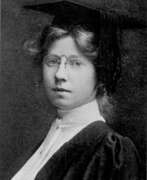

Imogen Cunningham was an American photographer known for her botanical photography, nudes, and industrial landscapes. Cunningham was a member of the California-based Group f/64, known for its dedication to the sharp-focus rendition of simple subjects.
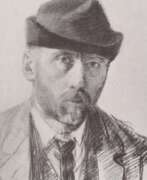

Frans Deutman was a Dutch painter. He graduated from the Antwerp Academy of Arts, a pupil of Charles Verlat. He belonged to the Laren School of painting, a direct continuation of the Hague School.
Frans Deutman is known for his portraits and figures in interiors.


Philip-Lorca diCorcia is an American photographer and artist. He is known for his staged and cinematic photographs that often blur the line between reality and fiction.
DiCorcia's work is characterized by his use of elaborate sets and lighting, which he uses to create images that are both beautiful and unsettling. Many of his photographs feature everyday people in staged settings, and he often uses strangers as his subjects, adding to the sense of mystery and voyeurism in his work.
DiCorcia has been the recipient of numerous awards and his work has been exhibited in galleries and museums around the world. He has also been commissioned to create photographs for a wide range of clients, including fashion magazines and advertising campaigns.
DiCorcia's legacy as an artist and photographer continues to influence new generations of artists. His innovative techniques and approach to photography have helped to redefine the medium and have had a significant impact on contemporary art and culture.
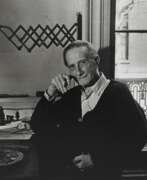

Henri-Robert-Marcel Duchamp, a pioneering French artist, is celebrated for his profound influence on 20th-century art and culture. Duchamp's work transcended traditional mediums, embracing painting, sculpture, and conceptual art, thereby redefining the very nature of artistic creation. His audacious approach to art, marked by intellectualism and wit, challenged conventional perceptions of beauty and utility, making him a central figure in the development of modern and postmodern art.
Duchamp's most notable contributions include his ready-mades—ordinary manufactured objects that he selected and presented as art. This innovative concept questioned the role of the artist and the creation process, exemplified by his famous piece, "Fountain," a porcelain urinal that radically altered the landscape of art by its mere presentation in 1917. His other significant works, like "Nude Descending a Staircase, No. 2," showcased his fascination with movement and mechanization, further cementing his legacy as a visionary.
Duchamp's influence extends beyond his creations, as he played a vital role in shaping the Dada movement and conceptual art. His ideas and artworks continue to inspire artists, collectors, and experts in the fields of art and antiques. Museums and galleries worldwide, including the Philadelphia Museum of Art and the Museum of Modern Art in New York, proudly house his works, attesting to his enduring relevance.
For those keen on exploring the intersections of art, culture, and history, Duchamp offers a rich tapestry of innovation and controversy. Collectors and art enthusiasts are invited to sign up for updates on new product sales and auction events related to Henri-Robert-Marcel Duchamp, ensuring they remain at the forefront of developments in this captivating domain.
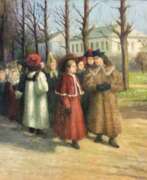

Ivan Osipovich Dudin (Russian: Иван Осипович Дудин) was a Russian and Soviet artist, painter, translator, and educator. He was born on January 19, 1867, in Moscow and passed away on April 4, 1924, in the same city. Dudin received his education at Moscow University and the Moscow School of Painting, Sculpture, and Architecture, where he was awarded the title of class artist in 1902.
Dudin is known for his landscapes, portraits, and genre scenes. His extensive travels influenced his works significantly. Since 1894, he regularly participated in exhibitions of the Moscow Society of Art Lovers and the Association of Traveling Art Exhibitions. Among his notable students were famous artists such as A.V. Kuprin, V.A. Favorsky, and V.I. Mukhina.
One of Dudin's significant works is "Blooming Garden" from 1902, which is exhibited in the State Tretyakov Gallery. His works can also be found in museums in Irkutsk, Kirov, and Krasnodar.
If you want to receive updates on new sales and auction events related to Ivan Osipovich Dudin, sign up for our updates. We will inform you only about new arrivals and events related to this artist.
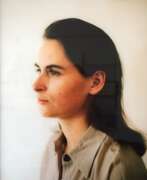

Jeanne Dunning is an American photographer whose work is centered around corporeality and human physicality in abstract forms. Dunning earned her Bachelor of Arts from Oberlin College and her Masters of Fine Arts from The School of the Art Institute of Chicago. From there, she opened her first exhibit at the Feature Gallery in Chicago in 1987. In the early 1990s, Dunning created a series of photographs for an exhibit titled "Directions" which was meant to blur the lines of fact and fiction.The exhibit was displayed at the Hirshhorn Museum in Washington. Dunning's work is included in the permanent collections of the Art Institute of Chicago, the Whitney Museum of American Art, the Museum of Contemporary Art, Chicago, the Museum of Contemporary Photography and the Museum of Modern Art, New York.
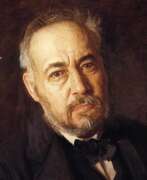

Thomas Cowperthwait Eakins was a pivotal figure in American realism, celebrated for his profound and uncompromising portrayal of the human figure. Born on July 25, 1844, in Philadelphia, Pennsylvania, Eakins dedicated his life to depicting authentic human experiences and emotions through painting, sculpture, and photography.
Eakins' education in art began at the Pennsylvania Academy of the Fine Arts and extended to studying abroad in Europe, where he was influenced by French realists and the anatomical precision in their work. His approach combined rigorous study of the human form with a realistic portrayal of American life, making significant contributions to both art and educational practices in the United States.
His notable works include "The Gross Clinic" and "Max Schmitt in a Single Scull," which showcase his mastery in combining technical skill with emotional depth. These pieces not only depict scenes from everyday life but also incorporate a level of detail that reveals Eakins' deep respect for the individuality and inner life of his subjects. Despite facing criticism during his lifetime, particularly for his unflinching realism and subjects considered controversial at the time, Eakins was posthumously recognized as one of America's foremost painters.
For those interested in learning more about Thomas Cowperthwait Eakins' life, works, and his impact on American art, visiting collections that feature his work, such as the Metropolitan Museum of Art and the Pennsylvania Academy of the Fine Arts, can offer deeper insights.
To stay updated on exhibitions, new findings, and auction events related to the remarkable works of Thomas Cowperthwait Eakins, consider signing up for our newsletter. Gain exclusive insights and early notifications tailored for collectors and art enthusiasts. This is an excellent opportunity to deepen your appreciation and knowledge of one of America's greatest realist artists. Subscribe today to ensure you don't miss out on these valuable updates!


Natalia Edenmont (Russian: Наталия Эденмонт), born Natalie Nicole Edenmont (Натали Николь Эденмонт), a Swedish-Ukrainian photo-based artist, has been carving a unique niche in the world of art since her move to Sweden from Yalta, Crimea, in 1991. Born in 1970, Edenmont's journey in art began with her studies at the State Art School of Kiev and continued at Simferopol State Art School in Crimea. Her talent and passion for art took a new direction at Forsberg’s International School of Design in Stockholm, Sweden, where she studied graphic design.
Nathalia Edenmont's work is a reflection of her personal experiences and inner visions. She is renowned for her distinctive approach to creating art, which involves visualizing the images in her mind in their entirety before capturing them. This meticulous process is evident in her stunning portraits of women adorned in dresses made of fruits, flowers, and even shimmering beetles, showcasing a blend of the natural and the fantastical.
Her portfolio is diverse, including the use of dead animals and animal parts in her photographs, a practice that might be controversial but is deeply symbolic. These creations are more than just visual spectacles; they are narratives of life, death, and the unspoken stories of nature.
Nathalia Edenmont's art has gained international recognition, with exhibitions held in prominent cities like London, New York, Berlin, and Moscow. Her works have found a place in both private and public collections globally, including esteemed institutions such as the Modern Museum in Stockholm, the Miami Art Museum, and the Moscow House of Photography Museum.
For collectors and art experts, Nathalia Edenmont’s works offer a glimpse into a world where art intersects with personal experience, nature, and introspection. Her unique vision and masterful execution make her pieces a valuable addition to any collection that seeks depth and a touch of the surreal.
If you are an enthusiast or collector of contemporary art and wish to stay updated on Nathalia Edenmont’s works, exhibitions, and sales, consider signing up for updates. This subscription will keep you informed about new opportunities to explore and acquire pieces from this remarkable artist's collection.
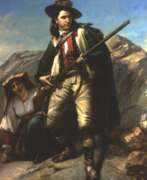

Johannes Hinderikus Egenberger was a Dutch painter, photographer and art educator. From 1840 to 1848, he studied at the Royal Academy of Fine Arts in Amsterdam with Jan Willem Pieneman. During these years, he focused on painting scenes from Dutch history. In 1854, he collaborated with Barend Wijnveld to produce a massive canvas depicting the heroic defense of Haarlem led by Kenau Hasselaer in 1573. Later, he would turn to landscapes, domestic scenes and portraits, including a series for the Rijksuniversiteit. In 1857, he was appointed Headmaster of the Academie Minerva in Groningen. In addition to his work there, he became a photographer and, in 1864, opened the first photography studio in Groningen. The following year, he resigned his position as Headmaster to devote himself entirely to photography.
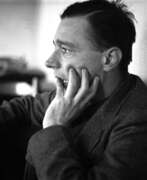

Walker Evans was an American photographer and photojournalist best known for his work for the Farm Security Administration (FSA) documenting the effects of the Great Depression. Much of Evans' work from the FSA period uses the large-format, 8×10-inch (200×250 mm) view camera. He said that his goal as a photographer was to make pictures that are "literate, authoritative, transcendent".
Many of his works are in the permanent collections of museums and have been the subject of retrospectives at such institutions as the Metropolitan Museum of Art or the George Eastman Museum.


Tom Fabritius is a German painter and graphic artist living and working in Leipzig, a representative of the so-called New Leipzig School.
Tom studied painting and drawing at the Academy of Visual Arts in Leipzig. In 2002 he co-founded the production gallery LIGA in Berlin-Mitte. Tom Fabritius paints in a wide variety of genres as he finds his motifs in the stream of images in the television. He switches between programs and quickly and intuitively captures individual moments of an image with his camera. From this collection, he selects individual images, which he then paints with watercolors.
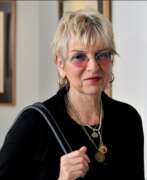

Audrey L. Flack is an American artist. Her work pioneered the art genre of photorealism and encompasses painting, sculpture, and photography. Flack's early work in the 1950s was abstract expressionist. But gradually, Flack became a New Realist and then evolved into photorealism during the 1960s. Audrey Flack is best known for her photo-realist paintings and was one of the first artists to use photographs as the basis for painting.[6] The genre, taking its cues from Pop Art, incorporates depictions of the real and the regular, from advertisements to cars to cosmetics. Flack's work brings in everyday household items like tubes of lipstick, perfume bottles, Hispanic Madonnas, and fruit.[6] These inanimate objects often disturb or crowd the pictorial space, which are often composed as table-top still lives. Flack often brings in actual accounts of history into her photorealist paintings, such as World War II' (Vanitas) and Kennedy Motorcade. Women were frequently the subject of her photo-realist paintings. She was the first photorealist painter to be added to the collection of the Museum of Modern Art in 1966.
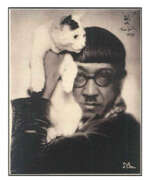

Tsugouharu Foujita was a French twentieth-century artist of Japanese descent. He is known for his unique style, combining elements of Japanese painting and printmaking with European realism.
Foujita created a wide range of works in a variety of genres, including nudes, images of cats, portraits of women and children, and self-portraits. He later converted to Catholicism and began creating paintings with religious themes. The artist was internationally recognized, and his work was exhibited in many countries around the world. His work was characterized by the perfection of pictorial technique, virtuosity of drawing and an atmosphere of sophistication. The master also showed talent in graphics, photography, ceramics, theater, cinema and fashion design. Prices for his paintings were comparable to those of Picasso's works.
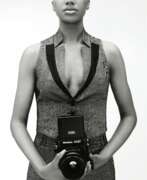

LaToya Ruby Frazier is an American visual artist, renowned for her profound work that delves into social justice, cultural change, and the American experience. Born in 1982 in Braddock, Pennsylvania, Frazier utilizes various media, including photography, video, and performance, to explore themes of industrialism, environmental justice, and human rights. Her art, deeply rooted in collaborative storytelling, often portrays her family and community, offering a lens into the lived experiences of working-class families amid societal and environmental challenges.
Her notable series "The Notion of Family" explores her family's life in Braddock, revealing the impacts of industrial decline on the community and environment. This work not only highlights LaToya Ruby Frazier's personal narrative but also serves as a broader commentary on race, class, and the American industrial landscape. Her commitment to social documentation is further exemplified in projects like "Flint is Family," where she immersed herself in Flint, Michigan, to document the water crisis's impact on local families.
LaToya Ruby Frazier's exhibitions span across prestigious venues in the US and Europe, reflecting her influence and recognition in the art world. Her works are part of esteemed collections like The Museum of Modern Art and the Whitney Museum of American Art in New York. Frazier's accolades include a MacArthur Fellowship, demonstrating her significant contributions to contemporary art and social activism.
For art collectors and experts, Frazier's work offers a compelling intersection of art, activism, and storytelling, providing insightful perspectives on pressing social issues through the lens of personal and community narratives.
To stay informed about LaToya Ruby Frazier's work and related updates, including new product sales and auction events, subscribing to updates is a valuable opportunity for enthusiasts and collectors alike to engage with her impactful artistry and advocacy.
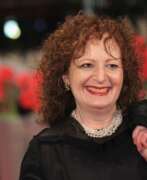

Nan Goldin is an acclaimed American photographer renowned for her profound visual narratives that delve into her personal world, marked by themes of addiction, sexuality, and intimate relationships. Born in Washington, D.C., in 1953, Goldin's journey into photography began in the early 1970s, capturing the lives of those around her, forming a "substitute family" amid a backdrop of drugs, sex, and violence.
One of Goldin's most celebrated works, "The Ballad of Sexual Dependency" (1986), is a raw and intimate portrayal of her "tribe," documenting their lives through the late 70s and early 80s in New York City. This work, initially presented as a slideshow, captures moments of love, sexuality, and domestic life, transcending into a poignant narrative of the era's challenges, particularly the AIDS crisis.
Throughout her career, Goldin's photography has continued to evolve, exploring various themes and mediums, including film. Her work, deeply personal and often autobiographical, challenges conventional perceptions of beauty, identity, and relationships, offering a window into the complexities of human connection and the essence of her subjects.
Goldin's influence extends beyond the art world, with her activism, particularly against the opioid crisis, marking another significant chapter in her journey. Her profound empathy and commitment to portraying the raw, unfiltered realities of life resonate through her extensive body of work, which continues to be celebrated in exhibitions and collections globally.
For art collectors and enthusiasts, Goldin's work offers not just aesthetic value but also deep emotional and historical resonance. To stay informed about Nan Goldin's works and related updates, signing up for newsletters from prominent galleries or her exhibitions could provide valuable insights and opportunities for engagement with her art.
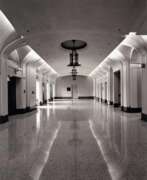

Doug Hall is an American photographer and media artist, who has received national and international recognition for his work in a range of practices including performance, installation, video, and large scale digital photography. He was a member of T. R. Uthco Collective (1970–1978). From 1981 to 2008, he was a member of faculty in the New Genres Department at the San Francisco Art Institute (SFAI). After retiring from the SFAI, he joined the Graduate Fine Arts faculty at the California College of the Arts (CCA) from 2008 to 2015.
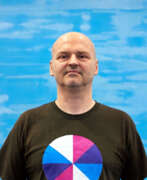

Eberhard Havekost is a German painter.
Havekost studied at the Dresden Academy of Art. Working from his own collection of photographs and videos, he reworked the original images on the computer: slightly changing the shades, subtly stretching and distorting the shapes. These transformations were then embodied in the drawing process, and the result is not photographic precision, but rather fleeting moments of abstract perception. Havekost often depicted modernist urban buildings as a means of referencing 20th century post-war politics and failed utopian visions. Hafecost also painted portraits and domestic paintings.
In 2010, Havekost was appointed professor of painting at the Academy of Fine Arts Düsseldorf. His work has been exhibited at major German and international institutions and is represented in numerous institutional and private collections.


Josef Herman was a Polish-British graphic artist, impressionist, and member of the Royal Academy of Arts. Herman's own style was bold and distinctive, with strong forms and minimal detail. He became famous for his depictions of miners, fishermen, and farmers, painting the modest, quiet beauty of the British working class in the postwar period. Herman also painted still life and nudes. His works are mostly in ink, watercolor, and pastel in dark, somber tones.
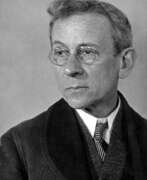

Lewis W. Hine was not an artist in the traditional sense, but rather a photographer and social documentary photographer who used his camera as a tool for social change. He is best known for his work in the early 20th century, documenting the living and working conditions of children in the United States.
Hine's photographs were instrumental in bringing about changes in child labor laws in the United States, and his images were used as evidence in court cases and Congressional hearings. He believed that photography could be a powerful tool for social reform, and he used his camera to highlight the injustices and hardships faced by working-class Americans.
In addition to his work as a photographer, Hine was also a teacher and an advocate for the arts. He taught at the Ethical Culture School in New York City, where he encouraged his students to use photography as a means of social commentary.
Hine's legacy as a photographer and social activist continues to inspire generations of artists and advocates for social justice. His photographs are considered a valuable historical record of life in the early 20th century, and his commitment to using art as a means of social change remains a powerful example of the role that artists can play in shaping society.
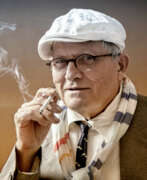

David Hockney, a British artist, has been a prominent figure in the art world for over six decades, renowned for his contributions to painting, drawing, printmaking, photography, and video art. His exploration of these mediums has made significant impacts on the Pop Art movement and beyond, making him one of the most influential artists of the 20th and 21st centuries. Hockney's work is celebrated for its vibrant color palette, emotional depth, and innovative use of technology in art.
One of Hockney's most distinctive features is his ability to blend traditional techniques with modern technology, notably in his iPad drawings and photographic collages. This fusion not only showcases his skillful adaptation to contemporary mediums but also highlights his ongoing quest to explore the nature of seeing and representation in art. Hockney's landscapes and portraits, characterized by their bright colors and meticulous detail, invite viewers to see the world through his unique perspective.
Significant works by Hockney, such as "A Bigger Splash" and "Portrait of an Artist (Pool with Two Figures)," are housed in major museums and galleries worldwide, attesting to his global influence and appeal. These pieces, among others, demonstrate Hockney's mastery over space, light, and narrative, securing his position as a pivotal figure in modern and contemporary art.
For collectors and experts in art and antiques, Hockney's oeuvre presents a fascinating study in the evolution of visual arts. His work not only offers insight into the artist's personal vision but also reflects broader cultural and technological shifts in society. As interest in Hockney's art continues to grow, keeping abreast of new sales and auction events becomes increasingly valuable.
To stay informed about the latest David Hockney sales and auction events, sign up for our updates. This subscription ensures that you receive timely notifications about new product sales and auction events related to David Hockney, offering unique opportunities for collectors and enthusiasts alike.
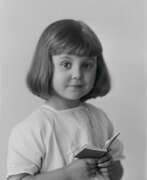

Ruth Miriam Hollick was an Australian portrait and fashion photographer who was one of Melbourne's leading Pictorialist photographers during the 1920s. There is evidence that Hollick was experimenting with photography in a home darkroom by 1907. The following year, she set herself up as a freelance photographer who toured rural areas of the state of Victoria, making portraits of families, especially children. She worked mostly outdoors in natural light with a field camera. By World War I, she had shifted into studio photography. It was in this period that Hollick developed a reputation for skillful use of both natural and studio lighting and for stylish compositions, often setting her subjects against plain backgrounds. She specialized in portraits of society figures and celebrities, as well as fashion photography for use in advertisements.
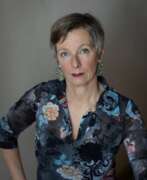

Elisabeth Hölzl is an Italian artist, sculptor and photographer who lives and works in Merano.
She studied art history in Innsbruck and then sculpture at the Academy of Fine Arts in Bologna. In the 1990s Elisabeth presented minimalist sculptures and installations to the public, later her work moved away from matter and turned to other media such as glass and light. In these works the focus is no longer on volumes, but on what makes them visible: light. In recent years, photography has become the artist's preferred medium of expression, and has accompanied his work from the beginning.


Dennis Lee Hopper was not only a prominent figure in the American film industry but also an accomplished photographer whose work captured the essence of a transformative era in the United States. Hopper's artistic journey spanned various mediums, with photography holding a special place in his array of talents. His photographic career, which began in earnest during the 1960s, offers a compelling glimpse into the cultural and social landscapes of the time.
Dennis Lee Hopper's photography is celebrated for its raw, candid portrayal of his surroundings, capturing moments that range from the intimate to the chaotic. His images provide a personal narrative of his life and times, reflecting his connections with key cultural and artistic figures of the era. His work is not just a collection of images but a visual diary, chronicling the vibrant and often tumultuous world he inhabited.
Notably, Dennis Lee Hopper's photographic portfolio offers an invaluable perspective on the American counterculture movement, showcasing his keen eye for composition and his ability to capture the spirit of the moment. His photographs, including portraits of famous contemporaries and snapshots of street scenes, resonate with authenticity and artistic integrity.
For collectors and enthusiasts in the realms of art and antiques, Dennis Lee Hopper's photographs represent a unique convergence of cinematic and photographic artistry. His works not only capture moments in time but also evoke the broader cultural shifts of his era. For those interested in exploring Hopper's photographic legacy, staying informed about exhibitions and auctions can provide opportunities to engage with his work more deeply and appreciate his contribution to the art of photography.
To stay updated on Dennis Lee Hopper's photographic works and related events, subscribing to updates from art galleries and auction houses is recommended. This subscription will provide timely information on new exhibitions, sales, and insights into Hopper's impact on the world of photography and art.
